– Forward –
A new section has been added in the right menu which contains important multiple page documents. These are important family historical documents that are scattered everywhere and are now in one place. Of note is the addition of Roberta’s Memoir Volume 1 and 2, which has been digitized and can be searched by key word when opened, eliminating the need to read many pages to find subjects. Also there are links in the text now. It is recommended you open them into a separate page for adjusting the settings in your browser. Of course this is too much to take in immediately, but it serves as a road map to refer back to as we move through the years of their lives. One can immediately see that important events are often crammed together with little time available for just relaxing, especially between 1900 and 1920. In particular, young Grace’s home life is shaken by the death of her father and the remarriage of her mother, all within five years, and then her step-father dies when she is a teen, followed a few years later by the death of her mother. Early Years 1846-1884 During this period the pioneer parents arrive in the West and our three subjects are born. CT was born in Douglas County near Eugene, Oregon in 1878 and Grace Elizabeth Suiter is born not far away in 1880 in Gervais, Marion County. Louie Lee Wade is born in Wallowa, Oregon in 1884. This is all we know from this period that is in the public. School Years 1886-98 Jesse and Sarah Hockett move from Douglas County to Grants Pass where CT attends school and graduates from Grants Pass high school. He then attends Ashland Normal College, however, in his sophomore year, on May 10th, 1898, he drops out and enlists to fight in the Spanish American War. This experience seems to influence CT for the rest of his life. More on this in the section on the Spanish American War. Grace’s early years are eventful. Her father, Edwin Suiter passes away in 1882 when Grace is two and her mother remarries John Aiken in 1887 when she is seven. John Aiken will also die in 1894 when Grace is a sophomore in high school. Grace first appears in the news in 1893 at thirteen years old singing a recital at a social ball. Grace will give numerous singing recitals through out her short life that are covered in the newspapers. She evidently was a very good singer. Her parents were from well respected families in the mid-Willamette Valley and were members of larger churches where music was important. In 1896 Grace graduates from high school. Louie Wade’s parents, Aaron and Mollie, first settled in Wallowa where Louie was born in 1884 (or ’85), the first of nine children. At the age of two she travels with her mother Mollie to Green River Wyoming where her father Aaron Wade was wintering with 100 head of horses he had driven from the County, intending to sell them in Kansas City. There are no railroads serving the area in those years. Photo of Louie as a baby. With the money from selling the horses her parents built a new house in Enterprise, where they lived for several years. They then moved to a shack on a farm on Alder Slope which eventually became the current locally famous grand Wade House. In the1900 census, while on the farm, Louie is age 17 and she is attending school. However, it isn’t clear which school, since at this time there still wasn’t a high school in the County. Young Adult Years 1898-1910 CT- In 1898 CT drops out of Ashland Normal School and joins the 2nd Oregon Volunteers, Company B to fight in the Spanish American War. He is shipped out to the Philippines via Hawaii. This was a common patriotic action by other Oregon college students at the time. Photo of CT in military gear. The war wasn’t much compared to modern wars; Roosevelt called it “a splendid little war” and historians have generally criticized it. For CT’s personal participation it is best to read his extensive letters home. His letters are peppered with naive hyperbole typical of a young adventurous man in a far off land. But there are also some interesting observational insights about a foreign people, foreshadowing a future analytical doctor and outward looking public servant. He did see some small action and came down with Typhoid, and while lying sick in the hospital thought about becoming a doctor. He served from 1898-99. During this period he came to the decision to become a doctor and enrolled in Willamette Medical School upon his return. Throughout his early years CT seems to be seeking out adventure, perhaps trying to recapture the thrill of his parent’s pioneer days and his Spanish American War year. Grace will have to tolerate this and follow him; we have no idea of her feelings about all this. CT enters Willamette Medical School in the fall of 1900 and graduates with the class of 1904. He is third from right in the first row. In this senior year he was house physician at the Salem City Hospital; indicating an impatience to get going. In 1910 Willamette would be criticized in a national medical study as not being academically rigorous enough and would be merged with the University of Oregon medical school in 1913 (called The Flexner Report). CT, however, used his intelligence through out his life to quickly learn how to be a competent doctor performing complex surgery and he was much respected in the medical community. This was the way for all doctors in the early 20th Century, as old school medical practices are giving way to the Age of Science. Grace- In 1897-98 Grace accompanies her mother Jennie Suiter to the East Coast where they remain for all of one year visiting relatives. Jennie hailed from Pennsylvania and her first deceased husband, Edwin Suiter, was from New York. Passenger train travel was getting more available and less arduous by this time, however, a cross country trip is still a major event. Grace and CT- In 1903 CT and Grace Suiter are married while he is in Med school, which would indicate they met each other somewhere in the Salem/Willamette University area while attending schools. See their photo at the top. Looking at the Time Life graphic between 1892 and 1912, this is an incredibly eventful period in their lives. Every year has an important event. In the same year 1903 that they get married Grace’s mother Jennie also dies. One year after CT’s graduation, Grace gives birth to Asahel Hockett in 1905 and Wayfe in 1908 (in Enterprise). Here they are as young children CT’s first private medical position in 1904 is in Cottage Grove where he joins a private practice with a Dr. Wall for three years. This must have been a an important event for Grace and CT. Shortly after this Dr. Wall will leave the practice in the hands of CT while Dr. Wall takes a post graduate surgery course in Chicago. This puts immediate pressure on a young green doctor to perform for patients. During this short period he is involved in treating a variety of serious injuries like the fellow who shot part of his arm off with a shotgun, and in treating a mortally wounded murder victim who he sits up with all night until death comes. In another case a railroad worker has both legs crushed and CT along with another doctor must do a double amputation above the knees. The operation was described in a full article in the newspaper and is both colorful and complimentary to CT. Here is the article- In 1905 CT is appointed to be the Cottage Grove Health Officer and in 1906 he is in negotiations to buy a drug store in nearby Yoncalla. In 1906 he is also appointed by the Governor to be a delegate to a national Tuberculosis Congress but cannot go because he is a witness in the murder trial (mentioned above). In September of 1906 he is considering moving into a new, larger office where he can install the latest in X-Ray equipment. In 1905 Grace and CT are reported at a large bicycling party (which was becoming a fad). In 1906 he and Grace go on a camping trip with baby Asahel. A lot of events, then a big move. Move To Wallowa County- Louie Wade- By 1900 Louie is 16 years old and probably out of elementary school but not in a high school since Enterprise did not have one yet. In 1903 her name occurs on a list of teacher’s aides working in Joseph and leading calisthenics in the school room. In 1903-04 she appears as a student in the Whitman College Catalog taking Harmony courses within the Music Department. She pays a tuition fee of $25.00 for the academic year (in 2024 dollars this is about $900). While at Whitman, she and some friends have their photo taken. Louie is second from the top. On the back of the photo other names are handwritten: Top = ?, 2nd = Louie Wade, 3rd = Jesse Wade (uncle Tone’s daughter) Bottom = Amy Wheeler (Aunt Alice’s daughter). I have not been able to make sense of the other names. In 1906 Louie is back at the large new home on Alder Slope house with her parents and puts on a large card party. The image we visualize from this description is completely 180° from the early image of her father, Aaron Wade. In his early days Aaron Wade was a rough cowboy character who frequently threatened, in the newspaper, to whip someone he disagreed with. So, Mollie Wade must now be running the household for this refined party to occur. Rolla Long and Louie Meet – Sometime after Whitman College Louie meets a man named Rolla Ivory Long and they enter into a relationship. In 1908 Louie is feted at a pre-wedding shower party. One other interesting fact about this party is that it is hosted by Mrs. John Rusk whom CT will run against in a few years for the legislature and they have serious words exchanged in the newspaper. The wedding happens on the following Sunday at the Wade home with 60 guests attending. The marriage of Louie to Rolla Long will begin a brief and tumultuous period for Louie Wade Long and Rolla Long. 1908-1916 Wallowa County Period By 1908 CT is actively involved in the County and Grace is expecting the birth of their second child, Wayfe. Grace is also actively involved in the local church. Grace also is involved other activities like the Ladies Aid of the Church and the Eastern Star fraternal organization in Joseph. CT becomes involved in civic affairs including helping to incorporate a state bank in the County, joining the Enterprise City Council in 1910, and being appointed to represent the County at the National Irrigation Congress in Spokane. In 1909 CT bring the first car to the County, a White Steamer. He must be feeling economically affluent. In the 1910 census CT is 32 years old, Grace is 30, Asahel is 4 and Wayfe is 2. In 1910 CT runs against John Rusk for the legislature and it develops into a heated debate in the local newspaper. CT and Rusk were both in many of the same organizations and apparently had a personality conflict. CT loses in this race but will win a couple of decades later. Louie Wade Long- Louie married Rolla Long in 1908 (see above) and by 1909 Vernon Long is born. In future years Vernon will become very close with the other children (Asahel, Wayfe, Jay and Ray) and will be viewed as just one of the family. Here is a photo of Wafe and Vernon. And here is Vernon later as a young man, probably around 1925-27. Louie’s marriage to Rolla Long was a complicated and tumultuous event in her life. Here is Roberta’s retelling of “The Love Letter” from her memoir, Volume 1, page 82-84. Rolla Long has a job as the elected County Surveyor in 1908, but abruptly resigns one year later; no explanation is given. At the same time there are two different lawsuits filed against Long in the Circuit Court. Later in life, Long shows up in the news for the Spanish American War and WWI, and dies in Post Falls, Idaho in 1974, but there is little else on him during the time Louie is seeing him. Rolla Long seems to have a blemished record at this time in the local papers and is not of reliable character. Unfortunately Louie’s short life with Rolla Long is not a happy one and the year after Vernon’s birth she files for divorce, since Rolla had left the County and was not coming back. Now Louie is a divorced young woman without a position, raising a young child in a County with few jobs other than physical labor. Naturally she and baby Vernon move back in with her parents on Alder Slope. She does attempt to make money by being a sales representative for clothing and fabric lines.
Grace is Mortally Sick- The year after Louie divorces Rolla Long, Grace Hockett becomes seriously ill in April of 1911. By May 13th she is still so ill she is removed from Wallowa County to Salem near her extended family. On May 23, 1911 Grace passes away at age 31 of Septic Peritonitis. There is nothing in historical records that indicates how CT felt about Grace’s passing. Grace is hardly mentioned in family writings and was never mentioned by relatives in my life. All we can see is that he did not pause in his outside activities. We know that he had two small children to take care of and a busy medical practice. We also know that in that time adults easily died from disease (e.g. Grace’s father, step-father, and mother) and that surviving spouses frequently remarried soon afterward. That was life in the West in the early 20th Century. Grace’s gravestone in the City View Cemetery, Salem, Oregon. It doesn’t seem right to quickly forget Grace, but pragmatism pushes the survivors onward. CT and Louie Wade Long Wed- If we look again at the time-line graphic following Grace’s passing it is obvious CT is moving beyond the “past”. Perhaps all the activity distracted him from his grief. He founds an effort to build a Carnegie Library in Enterprise, is still competing for a position in the legislature, and proposes to Louie that they marry, and they then have a quiet wedding ceremony. Roberta Hockett in her memoir says CT, after meeting Louie, believed “she would be a good mother to his own children and he would adopt Vernon.” A pragmatic union, not a romantic finding of your mate like Grace. In 1912 CT and Louie take a break from recent events to take a railroad trip to Louisville, Kentucky, where CT is a delegate to the Presbyterian Assembly. During the trip CT will also study medicine in Chicago at a hospital, and he also attended the Republican Convention in Chicago. This was probably somewhat of a honeymoon trip and relief from all the turmoil of the past two years. Asahel and Wayfe were left with relatives.
1914-1920 CT and Louie Hockett In 1914 the Carnegie Library in Enterprise is completed. CT was the primary driving force for obtaining the $5,000 funding from Andrew Carnegie. Carnegie funded 2,509 libraries in the U.S. It was one of the largest charitable gift movements in U.S. history. The next major event for the new family is the birth of fraternal twins Ray and Jay on May 2, 1914. For an extended discussion of their birth and relationships to the other children see Roberta’s Memoir, Vol. 2, page 133-135.
CT Hockett and Hospitals- The written history of hospitals in Wallowa County is often confusing since there were several small private ones before the main public hospital was completed in 1952. CT was involved in 3 different hospitals during his life. Toward the end he was advocating strongly to be done with private hospitals and for the voters to fund a public hospital. The early private hospitals were little more than a building with an operating room and a couple of rooms for convalescing patients. In 1979 a student, Ann Magill, did a research paper on the medical care in the County, and below is an excerpt for those pages that are applicable to CT. First, here is a telling quote about one such hospital owned in 1910 by Dr. Jack: “Magill interviewed Christine Sutphin, a former cook in Dr. Jack’s hospital, which also had its beds inconveniently sited at the top of steep stairs. Sutphin said that, during surgery, a note stuck to the kitchen door would ask her to be quick in preparing food so she could help him in the surgery.” Here is the section about CT Hockett’s hospitals… Based on Ann Magill history paper of 1979 and re-written by Elane Dickenson of the Chieftain in 2007.Excerpt regarding history of hospitals in the County… “In Enterprise, Dr. Clyde T. Hockett, who was to practice here until his death in 1943, opened a hospital next to his office, where the Enterprise Elks Lodge is now located (W.North and NW 2nd). He partnered with Dr. Taylor. Hockett, a veteran of the Spanish American war, enlisted, or was drafted, into WWI. Upon his return, he bought a second hospital, located in the Bollman Funeral Home building. In 1919, Dr. Ben F. Roseman bought and remodeled the old county high school building, built of Bowlby stone, on the hill overlooking the present Enterprise schools; and the next year was purchased by Dr. Hockett, who saw the need to consolidate the Enterprise hospitals into one.
Dr. Hockett remained the principal owner and hospital manager of the Enterprise Hospital – the immediate predecessor of Wallowa Memorial Hospital – the rest of his life. He struggled, at times, to keep the hospital’s financial head above water, often accepting livestock and other farm items for payment. Thus, he ended up in the agriculture as well as the medical business, and his Upper Prairie Creek ranch still remains in the Hockett family today. Vegetables grown in the backyard and the hospital’s milk cow and chickens helped feed the patients.” Dr. Hockett was always optimistic that the county would take over the hospital, but it wasn’t until after his death in 1943 that his desire was finally fulfilled. World War I and Captain CT Hockett, 39th Regiment, Camp Lewis World War I began in 1914 and the U.S. entered the war in 1917. By June of 1918 CT is on duty at the Camp Lewis Infirmary caring for two battalions of 1,000 men each. Here is a letter home by Captain Hockett… Besides returning wounded, the most pressing issue was the Pandemic of 1918-19 that started in military camps and then swept through the U.S. and the world. Between 20 and 40% of all military personnel contracted influenza and pneumonia. In the War, 43% of deaths came from battle compared to 50% from disease. September to November of 1918 was the worst period for deaths in the Army. Camp Lewis did not have as many deaths as some bases elsewhere in the Country, but they did have a high rate of sickness. It is sometime during the war years that this well known photo was taken with Ray and Jay.
High School and College Years- The post-war period is more settled, less dramatic, and more family oriented. During these years of the early 1920’s Louie is in the newspapers almost every week attending a social gathering of literary discussions, card parties, or club get-togethers. In that age Wallowa County, residents were highly social, especially with the advent of better roads and more modern automobiles. During this period of the early 1920’s they are a busy family with lots of school activities. In the 1920 census CT is 41, Louie 35, Asahel 14, Wayfe 11, Vernon 11, and Jay and Ray are 5, and they are all legally located in Enterprise. They also have a 17 year old girl named Agnes Wilcox living with them, probably to help with the children. Photo of Louie with Jay and Ray when they are about six. However, Asahel has been attending Jefferson high school in Portland during the war years starting in 1918, and did not go to high school in the County. Likewise Wafe starts high school at Lincoln in Portland in 1921. Roberta says they stayed with Jay and Wayfe Bowerman who lived in southeast Portland. Jefferson is not far from the grandparents Jesse and Sarah in NE Portland at this time. However, Lincoln is on the other side of the river; a lot of bus rides. CT may have felt strongly that the Portland high schools were better preparatory for attending medical school. I wonder if this was also a promise made to Grace before she died, to make sure of Asahel and Wayfe’s educations. By the late 1920’s Asahel, Wayfe, and Vernon are all attending colleges in Eugene or Corvallis. Reading the Wallowa County newspapers in this era it is amazing how many of the County’s young people are returning from college during the holiday season. At that time rural Wallowa County very much believed in education. Wayfe at the U of O pledges Alpha Xi Delta sorority in 1926 and by her senior year she is president of the house. She is active in a number of organizations and becomes a talented dancer putting on shows. Photo of house presidents below in 1930; Wayfe is far left in the front row. Wayfe would go on to run a real estate company in the San Diego area. It should be pointed out that women are no longer being pushed aside by the men in 1930 as they were in 1900. By 1930 Vernon has switched to engineering at Oregon State College. Vernon will marry Maxine Pfeiffer in 1932. So by the mid to late 1920’s all the children have left the County except for Ray and Jay. A quieter time at home. Most of the news about CT during the 1920’s is regarding treating different patients, the exchange of deeds on property he is investing in, and numerous court filings by CT against others to collect on debts they owe him. CT First Injury Accident
However, in 1925 CT suffers the first of two serious injury accidents, this one is in his car and a later one is on a horse in 1941. In this one CT is driving out to The Buttes north of Enterprise where he and Louie had some grazing land (part of Aaron Wade inheritance). Articles discussing his later health issues will refer back to this wreck as part of continuing health issues due to injuries from accidents. In 1928 CT and Louie moved into a new, large brown house on East Main Street across from the high school. The house had four bedrooms upstairs, an enclosed attic with two beds, and lots of storage. CT always had extra folks staying in this house, either for medical reasons (patients), students, or relatives in need. For example, his brother Guy lived in Wyoming and when his wife Flo died CT took in Guy’s three children for one year: Stanley 9, Lynette 13, and Orel 17. CT was the “go to guy”; if something happened in the extended family all said “Call Clyde”, who always responded. The kids cried a lot but went back to Wyoming after one year when Guy remarried. Orel stayed and graduated from Enterprise High. Sunday 26th
Dad and Asahel got up at 5:30 AM and went deep sea fishing on Bayou (or a canal). Returned about 5PM with a lot of fish of several kinds – also a lot of crabs which we cooked and ate that eve.
After New Orleans they head for Madison Wisconsin where Wayfe (CT and Grace’s daughter), husband Roger, and daughter Susan DeBusk live. Roger DeBusk is also a doctor there. Later Sara Jane will be born to Wayfe. Sara Jane and Susan will spend a summer at the ranch in Joseph in the 50’s. Susan took the photos of David, Clyde, and Roger playing cowboys and Indians on Old Paint.
Movement To Merge Private Hospitals and Found A Public Hospital- At some point CT seems to be tiring from all the administrative effort and financial burden to provide a private hospital for the county. In 1938 he begins consolidating equipment and purchasing new equipment in an attempt to provide better services. Between 1938 and his death in 1943 there will be many articles in the papers about his effort to push the voters to fund a public hospital, which will finally be accomplished in 1952. Blurb in the papers in 1938: See the hospital documents in the sidebar for a full recounting of the history. Here is a brief summary from Chieftain editorials April, 1943: The Enterprise hospital which has served the residents of Wallowa county for almost a quarter of a century may be closed within the next few days according to an announcement by Dr. C. T. Hockett. While efforts are being made to keep the hospital open and no decision will be reached until after the matter is taken up with the county court at its regular monthly meeting next Wednesday, the likelihood that the hospital will continue to function appears slim at this time.
Dr. Hockett states that the present crisis in the hospital’s history is due to two factors primarily: first, the revenues of the hospital are hardly sufficient to meet operating costs, and second, it has become almost impossible to secure and keep an adequate staff of nurses and other personnel. CT dies of heart failure not too long after this is published and one wonders if all the stress was a contributing factor. For decades the anti-tax public had pushed the burden of providing hospital services off onto private doctors like CT, who never made any money off of it, only headaches. In 1946 the hospital issue is put to the voters: “In one of the heaviest off-year election votes in the history of the county voters turned in an overwhelming vote for most of the Republican candidates. The proposition to build a county hospital carried by a substantial majority and accounted for much of the interest manifested in the election. The measure lost votes in Wallowa and Lostine but piled up more than a three to one lead in Enterprise and also carried in most of the other precincts.” By 1948 funds are approved to build a new public hospital in the County and it is completed in early 1952.
The Decline in CT’s Health, 1941 to 1943 By 1940 CT is still active in local politics, running for County Judge in 1942, and helping Mervin Horner and Everett Talbot on his range land on The Divide in 1941. Mervin will later be Ray’s hired man, living in the new Little House on Prairie Creek. The year following the horse accident, 1942, CT suffers an apparent heart attack, a forewarning of the future. Dr Hockett Better After Brief Attack “Dr C T Hockett was taken to the hospital Monday for rest after he had about collapsed at his home that morning. He had been at his Prairie Creek ranch Sunday afternoon and had worked until he was too tired. After a day of rest at the hospital he regained his strength. Meanwhile Mrs. Hockett had gone to Portland Sunday to be with her sister Mrs. R E Riley who was to have a major operation Tuesday morning at a private hospital. Mrs. Riley wife of the mayor of Portland has been in a hospital since last October preparing for the operation. Without waiting for it Mrs. Hockett left Portland Monday evening and hurried home , and was greatly relieved to find her husband much better and quite comfortable.” Chieftain April 16, 1942 As of April 23rd he is still in the hospital. By May he is improving, and in July he is at home. But this is after a train trip to Illinois, which means that he is impatient and pushing himself too hard.
Louie Wade Hockett Lives On- Louie lived for awhile on the second floor of an apartment building across from the library that CT built. I use to pull all the toys out of the cubby under her writing desk. She also had a refrigerator-ice box with one of those round compressors mounted on top. She was still living in the 30’s in the 50’s. In the 50’s she and sister Great Aunt Annis moved into the Mann Home in the Hollywood District of Portland. The Mann Home was founded in 1893 for older retired people and was a beautiful home with expensive antiques in the hallways that had been donated from prior residents. Dad and I use to visit her there in the winter when things quieted down at the ranch. She was always proud to have us take lunch with her in the big dining room and show off to the other retirees her ranch owning son and grandson from well known Wallowa County. During the fifties and sixties Louie frequently summered in Wallowa County staying with Great Aunt Wayfe (Jay Bowerman’s wife and CT’s sister) at the Bowerman cabin on the slopes of Mount Joseph. Many times Dad and I sat in the living room with the stone fireplace eating cake and cookies and talking with Louie and Wayfe, and sometimes Annis was there too. The family was very tight then and it did not matter whether relatives lived in the County or in Portland, they all gladly gathered to catch up on family news. Bowerman Place, Joseph Ore.-
Notice of service for Louie in 1974-
Summary- It’s difficult to easily summarize such event filled lives, lasting from 1874 to 1974, 100 years of ups and downs, but never boring. CT in his early years seems like a driven man, who could never be satisfied to live a quiet life. One would like to know more about Grace and whether all this turmoil was a burden to her. Louie seems to have been the most contented of the three. She seemed to be content to be the wife of the important doctor in the community and to care for the children and commune with all the relatives. From my perspective it has been a valuable project to finally bring into focus the time and lives of relatives that were always fuzzy and only briefly noted when told to us as younger family members .
Narrative of The Lives of Clyde Toney Hockett, Grace Suiter Hockett, and Louie Wade Hockett
Historical Narrative For The Lives of
Clyde Toney Hockett, Grace Suiter Hockett, and Louie Wade Hockett
As we shall shortly see, these three intertwined Hockett relatives lived very eventful lives during a time of great change in the American West. After reading all of the dozens of newspaper articles and other family writings about them, one comes to understand they lived at the edge of excitement and tragedy. Life was much less predictable at the beginning of the 20th Century.
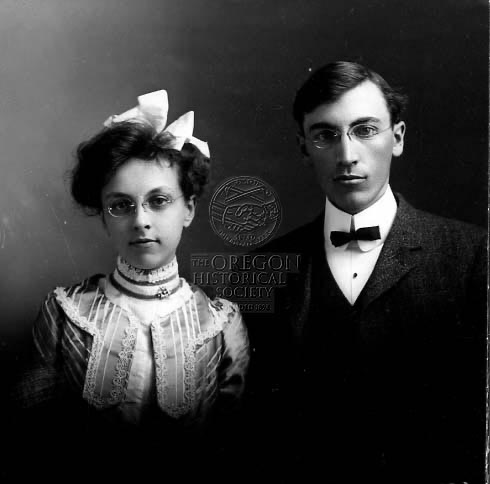
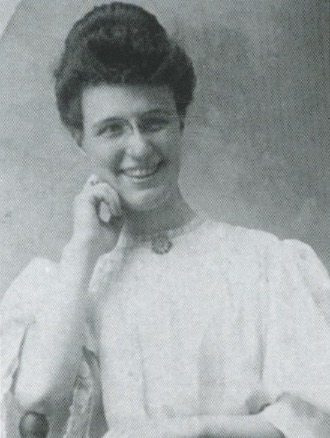 The portraits above show the three of them at relatively young ages. The first one is Grace and CT probably at their wedding. Louie’s photo is taken in her twenties. The photo of CT and Grace is startling. The magnetism between the two is very strong. Theirs was a marriage of young, romantic love. Grace would die eight years later. Louie’s photo is of a woman raising five children whose marriage to CT was a practical necessity…both were recently single and needed to find a home immediately for three young children. Intermixed with the lives of these two women, CT had an intense need to achieve an endless variety of accomplishments outside the home…even in the midst of domestic tragedy. In that age there was not a lot of time for grief and reflection; there were practical needs to be taken care of, seeing to the children.
To begin this unveiling of their complicated lives it is useful to see it all laid out at one glance in the time-life graphic below. There are three colors and black. Black is for dates related to Jesse and Sarah Hockett (CT’s parents) and CT’s siblings. The colors are as indicated in the legend. There is a pdf copy of this graphic in the right menu bar which can be opened in a separate window do you can follow along as you read.
The portraits above show the three of them at relatively young ages. The first one is Grace and CT probably at their wedding. Louie’s photo is taken in her twenties. The photo of CT and Grace is startling. The magnetism between the two is very strong. Theirs was a marriage of young, romantic love. Grace would die eight years later. Louie’s photo is of a woman raising five children whose marriage to CT was a practical necessity…both were recently single and needed to find a home immediately for three young children. Intermixed with the lives of these two women, CT had an intense need to achieve an endless variety of accomplishments outside the home…even in the midst of domestic tragedy. In that age there was not a lot of time for grief and reflection; there were practical needs to be taken care of, seeing to the children.
To begin this unveiling of their complicated lives it is useful to see it all laid out at one glance in the time-life graphic below. There are three colors and black. Black is for dates related to Jesse and Sarah Hockett (CT’s parents) and CT’s siblings. The colors are as indicated in the legend. There is a pdf copy of this graphic in the right menu bar which can be opened in a separate window do you can follow along as you read.
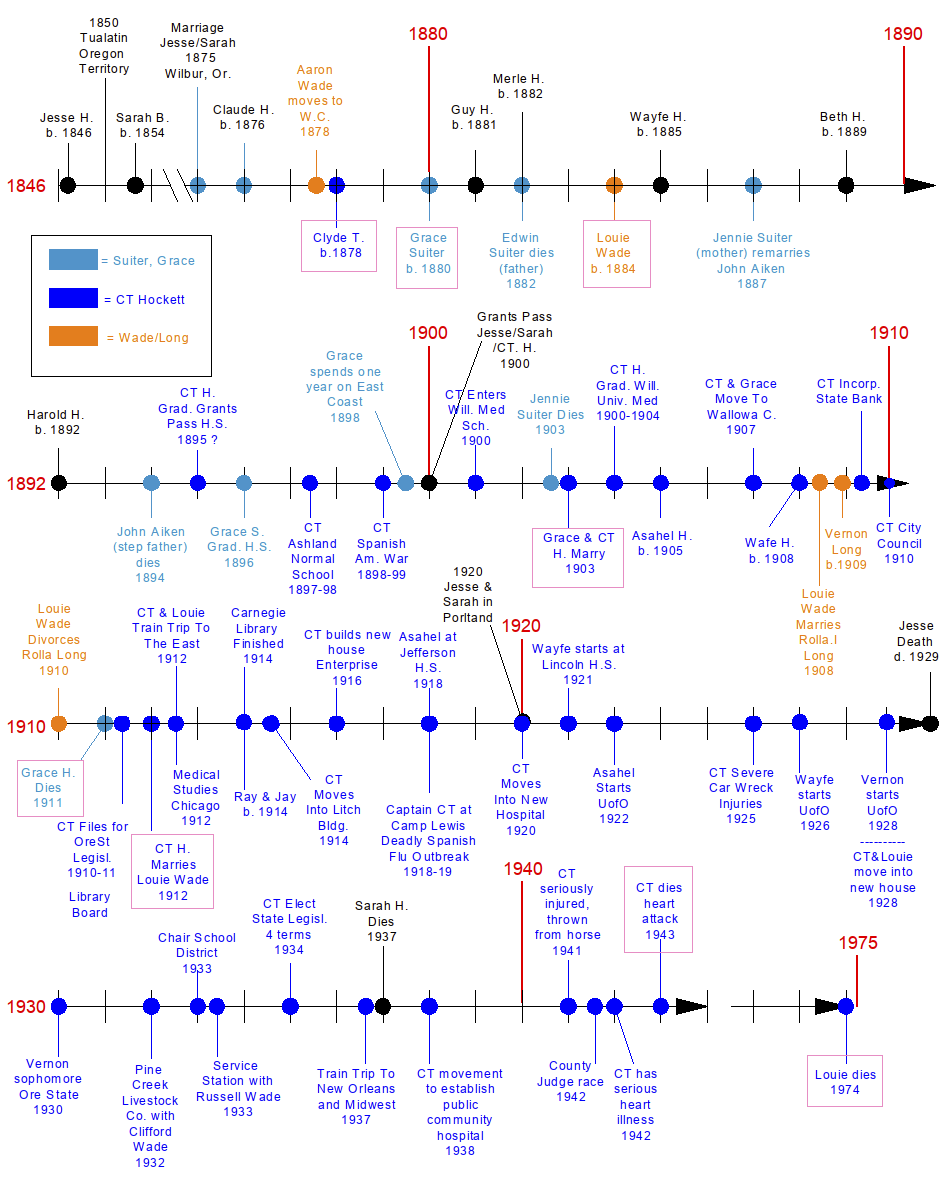

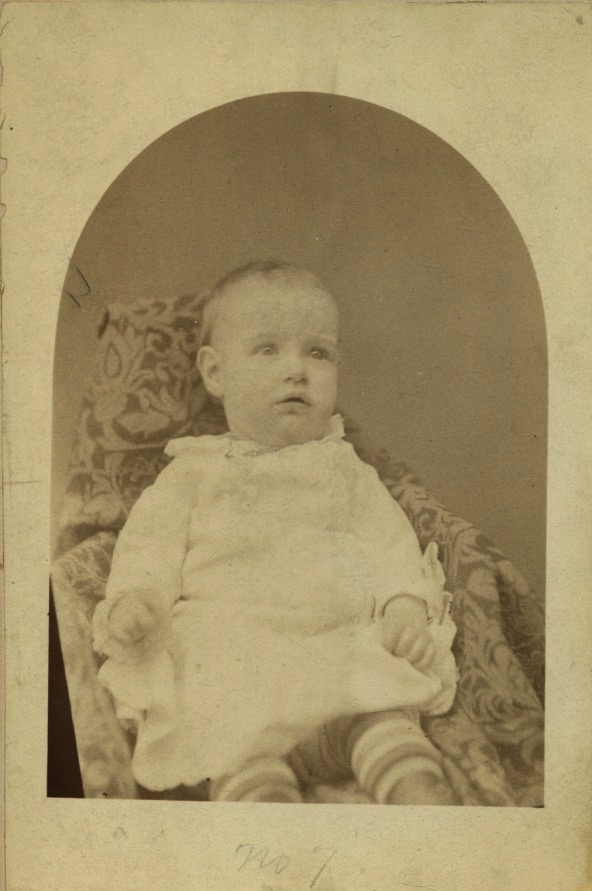
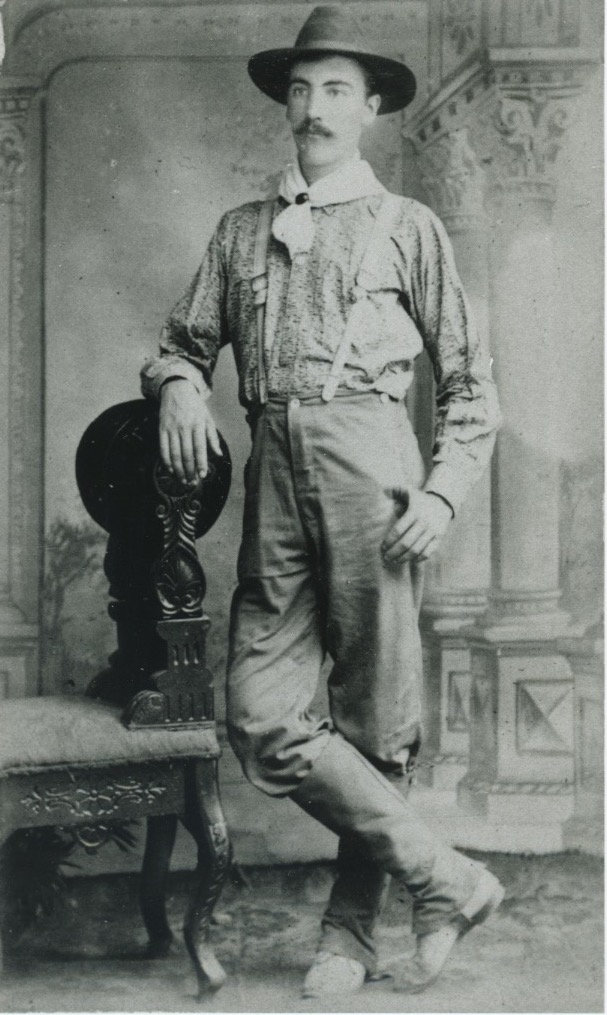
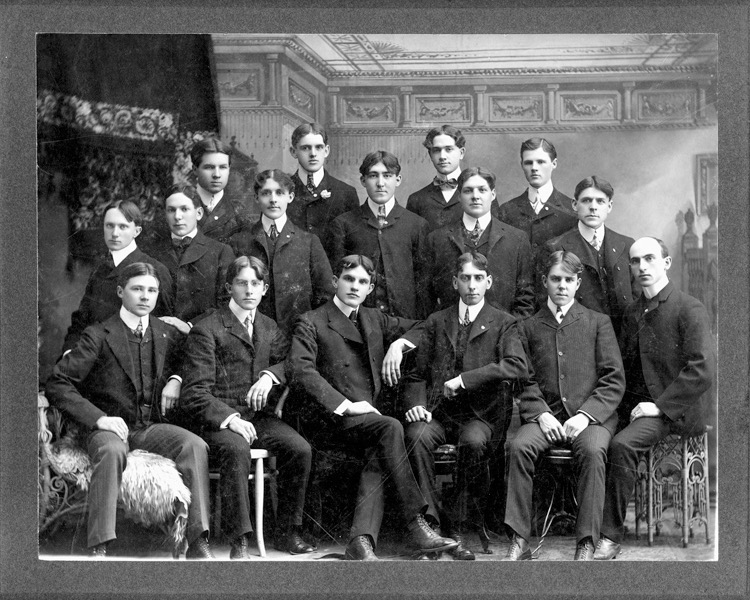
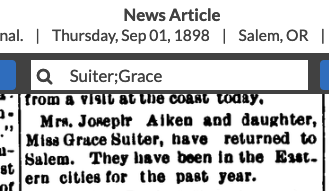

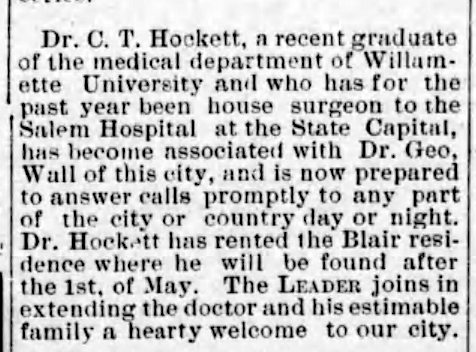
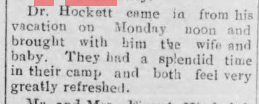
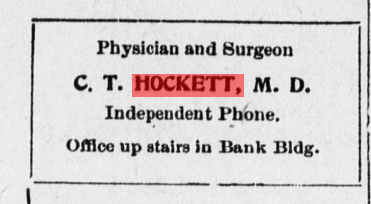

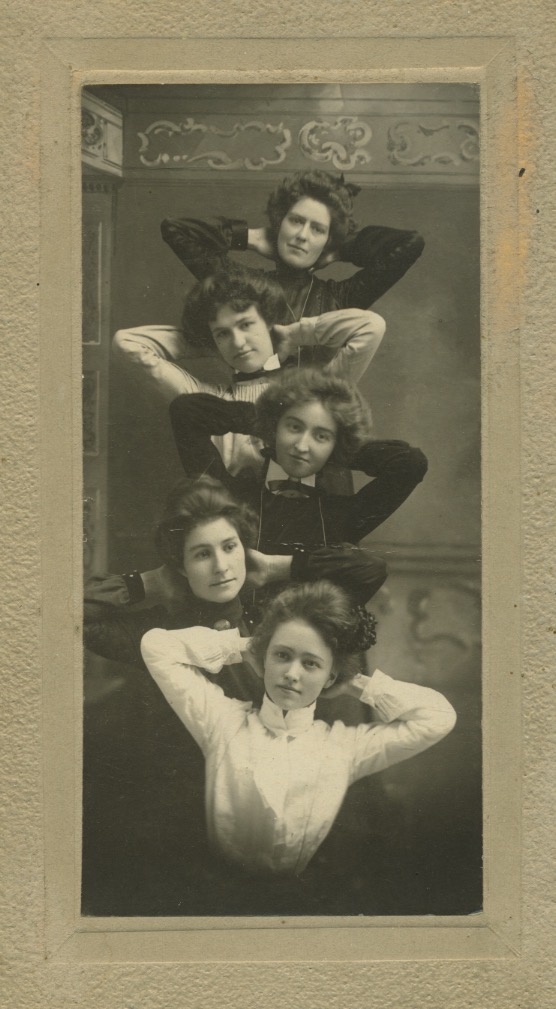
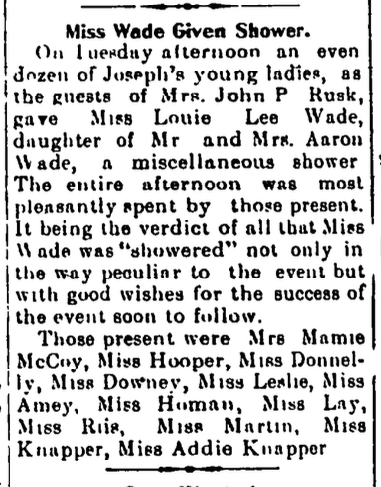
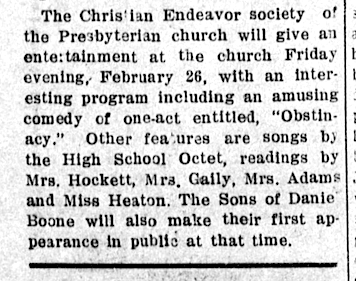
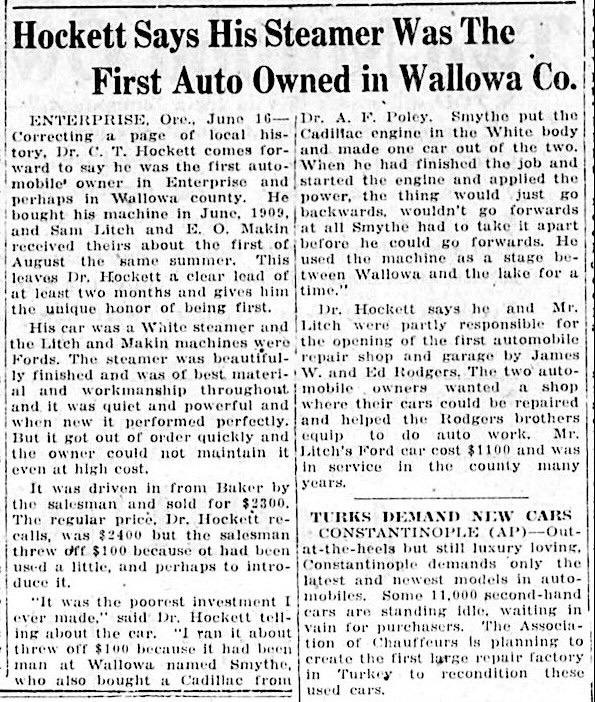
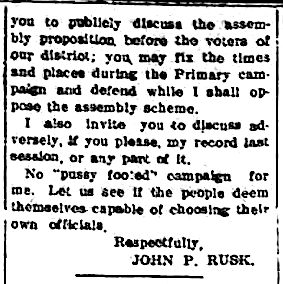


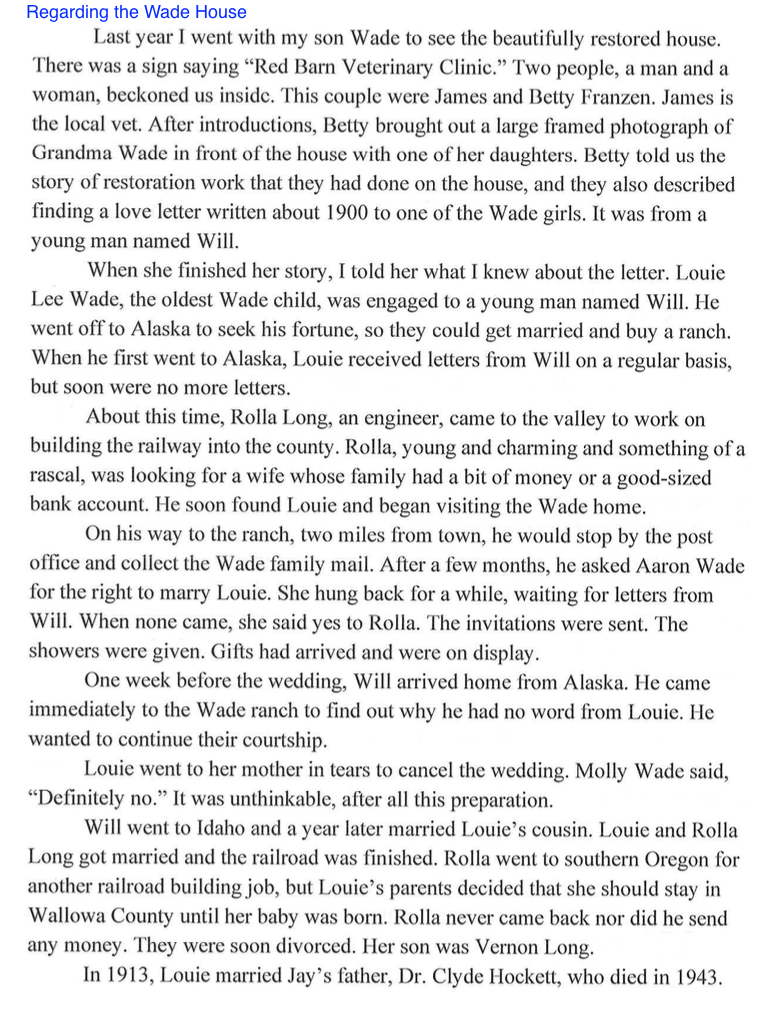

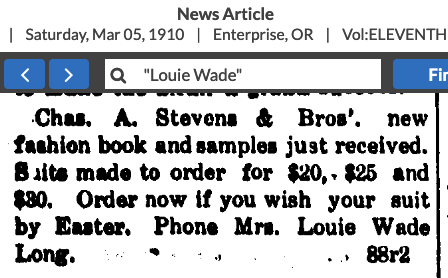

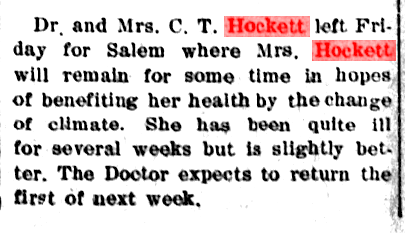
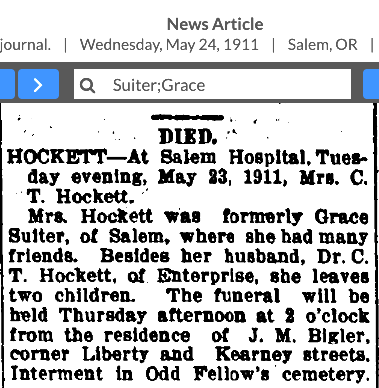
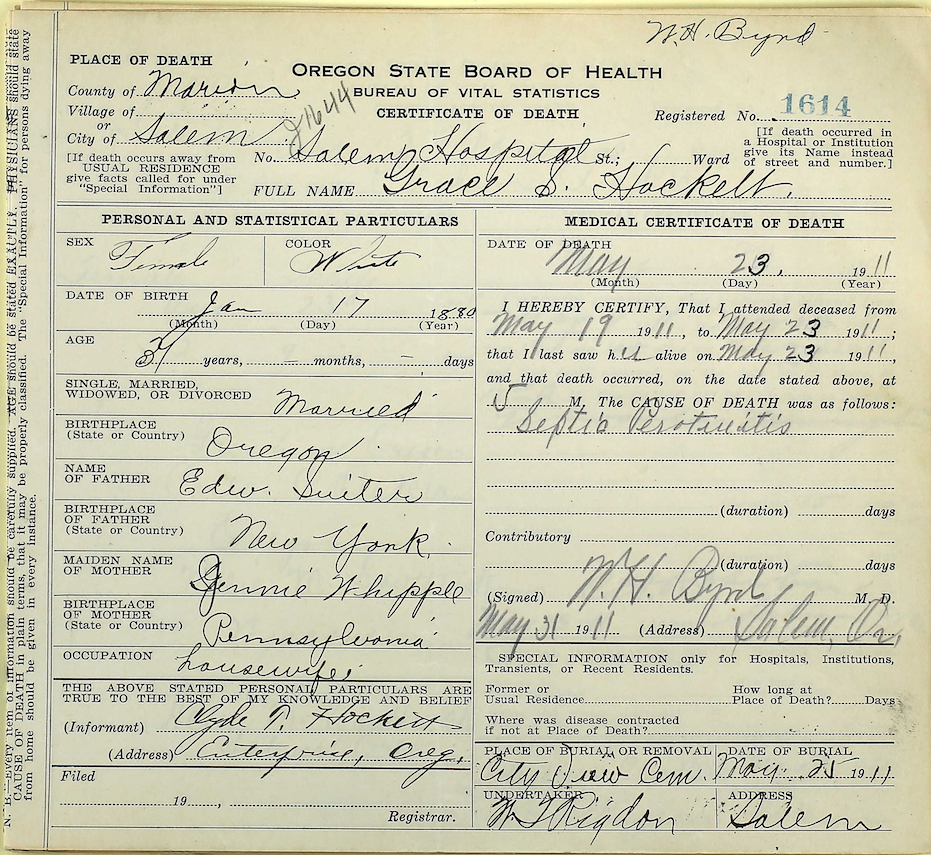
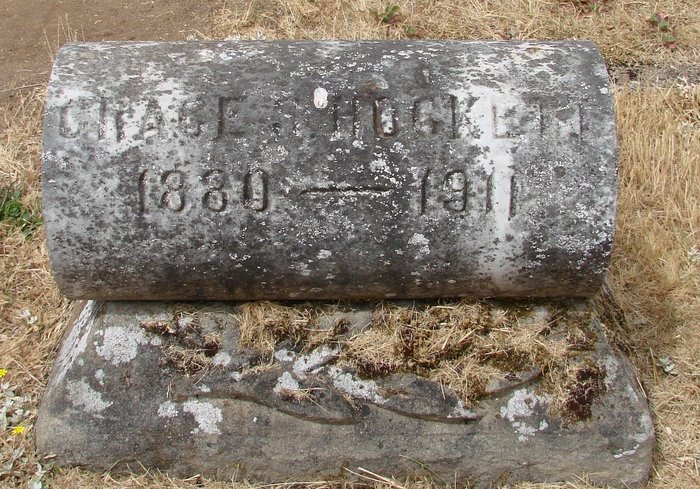
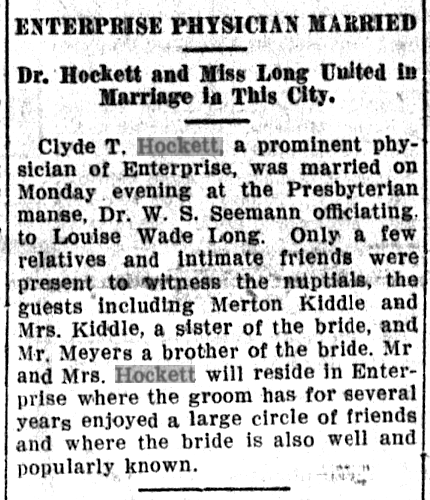
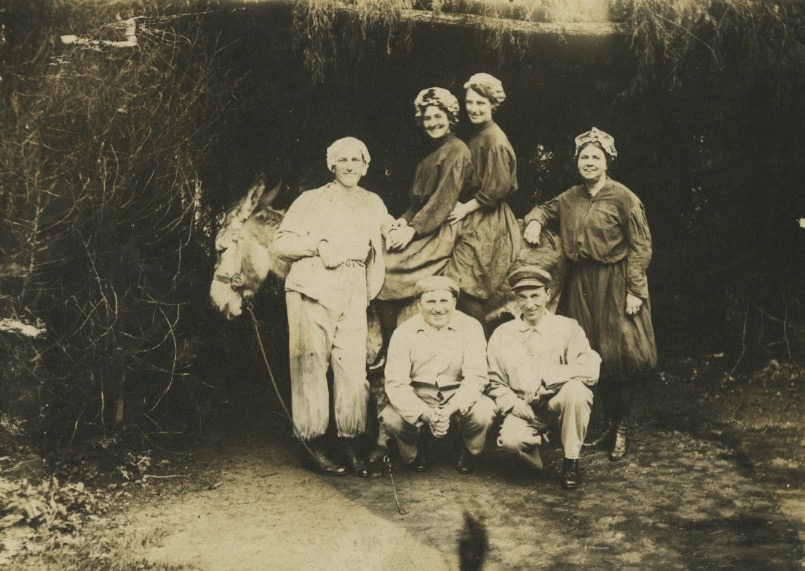 Louie wrote a diary of this trip and CT sent postcards, which Renee Hockett transcribed (see Train Trip in sidebar). Some of CT’s postcards back to the children use the “N” word and reveal racial bias. One wonders if this was just the age he lived in or whether CT really felt this way. It is the only instance of recorded bigotry in his life. During the trip Louie became ill and was laid up in hotels for several days. From Chicago they traveled down to New Orleans, then on through Texas, Arizona, and on to Los Angeles and back up the Coast.
Louie wrote a diary of this trip and CT sent postcards, which Renee Hockett transcribed (see Train Trip in sidebar). Some of CT’s postcards back to the children use the “N” word and reveal racial bias. One wonders if this was just the age he lived in or whether CT really felt this way. It is the only instance of recorded bigotry in his life. During the trip Louie became ill and was laid up in hotels for several days. From Chicago they traveled down to New Orleans, then on through Texas, Arizona, and on to Los Angeles and back up the Coast.


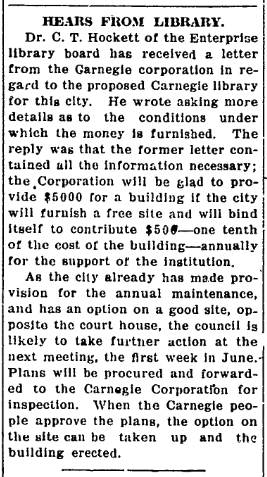
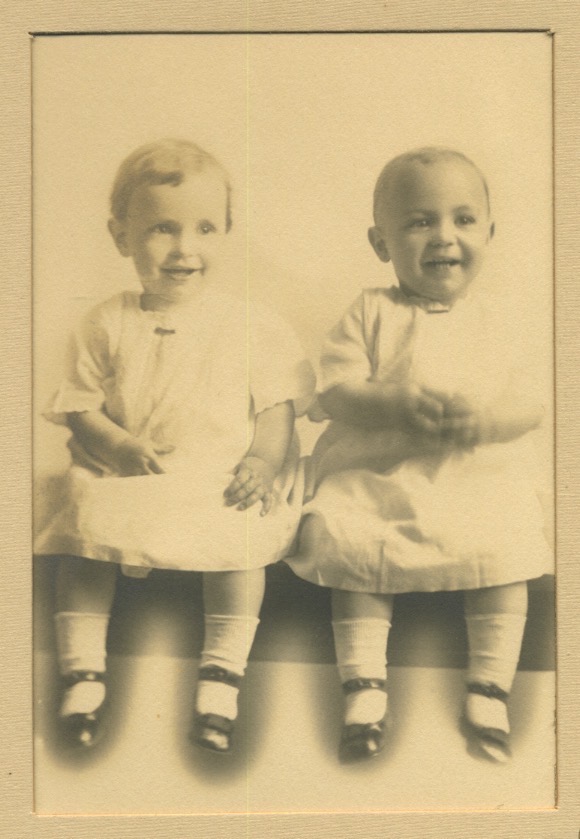

 The house is on 1900 South Depot Street, which runs straight North to CT’s first office and his hospital (later became Bollman Funeral Home) at the corner of Main and Depot. The barn is older and its status is unknown.
During this period Louie is also busy with social activities in the County including a literary club where book reviews and historical articles are presented and discussed. We also learn that Louie plays the piano.
The house is on 1900 South Depot Street, which runs straight North to CT’s first office and his hospital (later became Bollman Funeral Home) at the corner of Main and Depot. The barn is older and its status is unknown.
During this period Louie is also busy with social activities in the County including a literary club where book reviews and historical articles are presented and discussed. We also learn that Louie plays the piano.
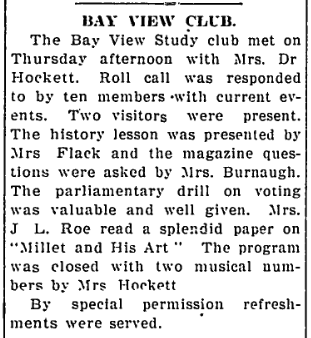 She also hosts a surprise birthday party for CT in 1916 which tells us that they are both enjoying each other’s company. This will continue for the rest of their lives; a practical marriage turns into true affection.
She also hosts a surprise birthday party for CT in 1916 which tells us that they are both enjoying each other’s company. This will continue for the rest of their lives; a practical marriage turns into true affection.
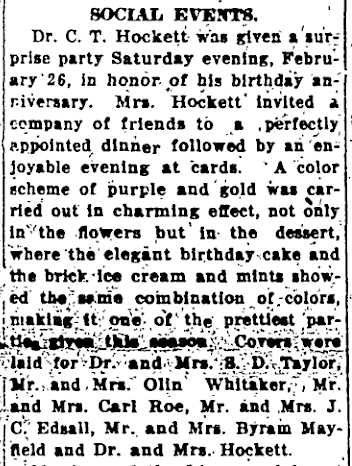
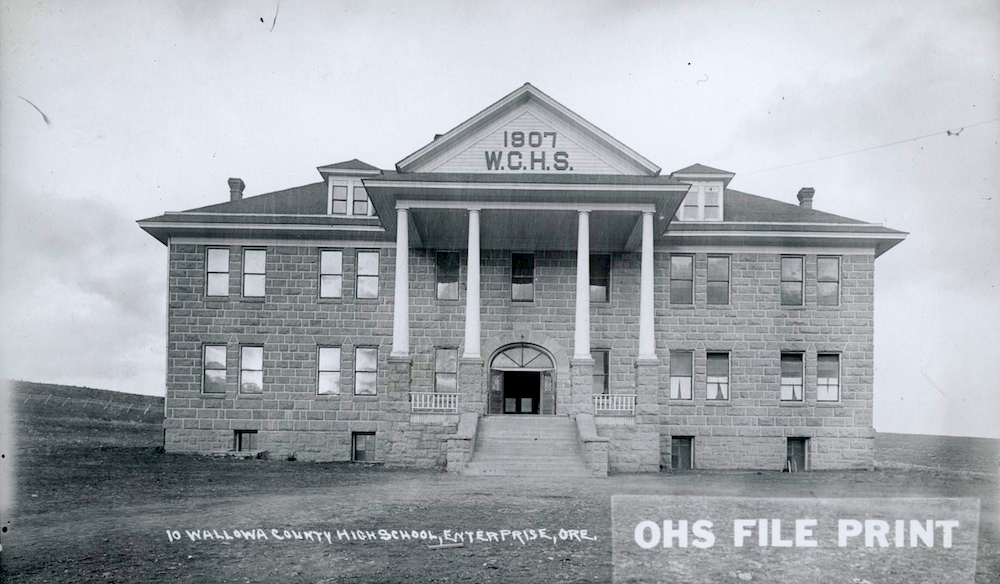 CT’s office was not at the hospital, instead it was located with other professionals in legal/medical/dental in the Litch Building (below) which was built around 1908-09 and was considered one of the finer building in Eastern Oregon at that time, and is currently being renovated to be a hotel bed-breakfast. During the fifties it was occupied by Holman Drug Store. It is across from the Court House.
CT’s office was not at the hospital, instead it was located with other professionals in legal/medical/dental in the Litch Building (below) which was built around 1908-09 and was considered one of the finer building in Eastern Oregon at that time, and is currently being renovated to be a hotel bed-breakfast. During the fifties it was occupied by Holman Drug Store. It is across from the Court House.
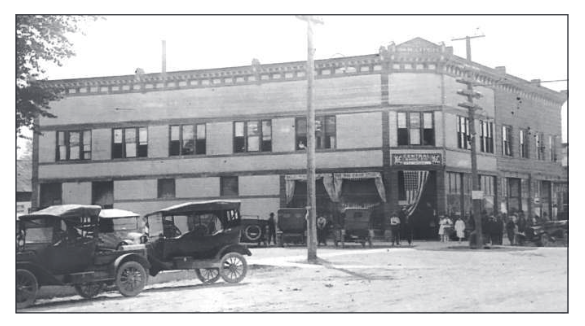 CT moved into the Litch Building in 1914.
CT moved into the Litch Building in 1914.

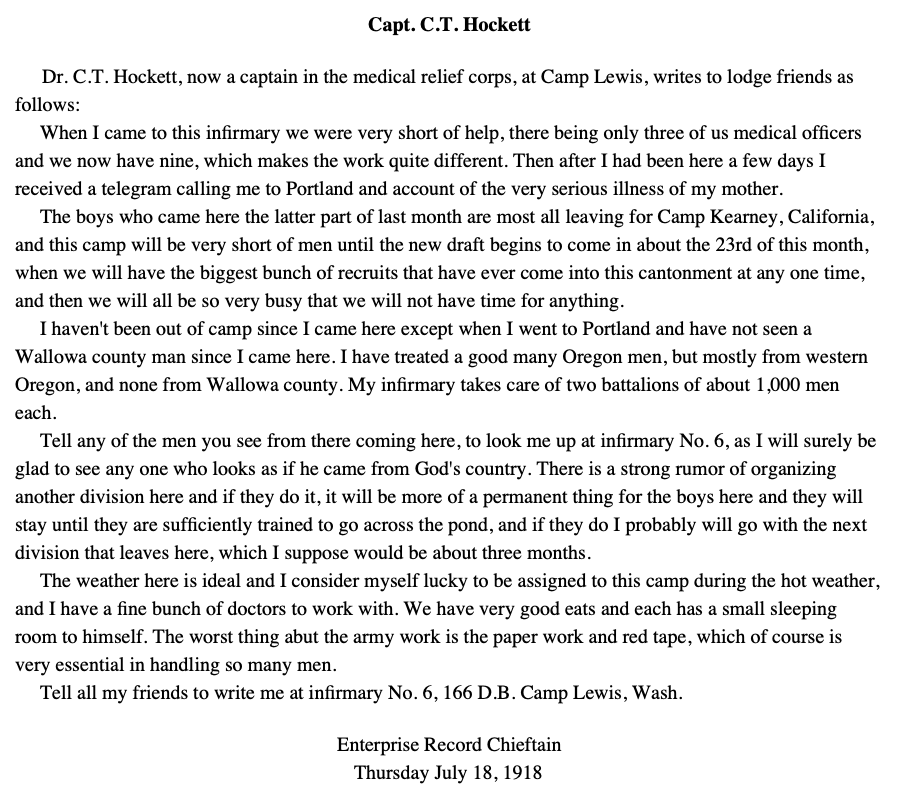
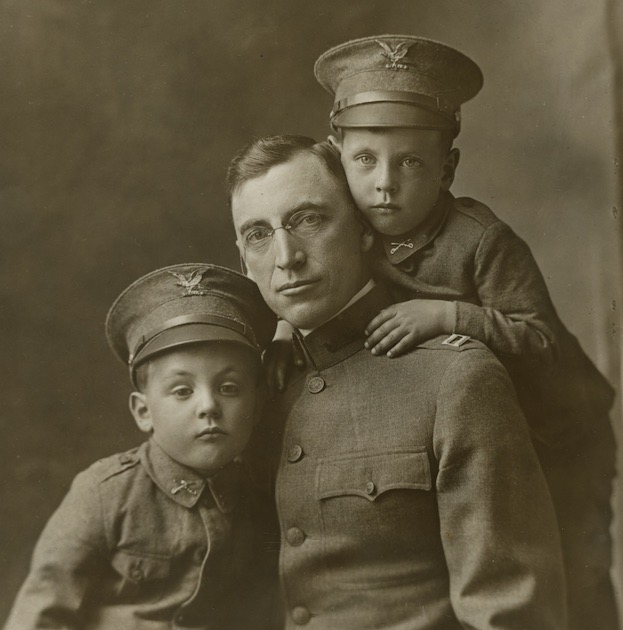 CT leaves the army in April of 1919 and he is later promoted to Major on leaving.
CT leaves the army in April of 1919 and he is later promoted to Major on leaving.
 By 1920 CT is back to his usual rural habits, one of which was hunting. Modern folks should remember that wild game was a standard staple of diets in rural areas in the first half of the 20th Century.
By 1920 CT is back to his usual rural habits, one of which was hunting. Modern folks should remember that wild game was a standard staple of diets in rural areas in the first half of the 20th Century.
 Here is a later hunting photo, probably in the 1930’s.
Here is a later hunting photo, probably in the 1930’s.

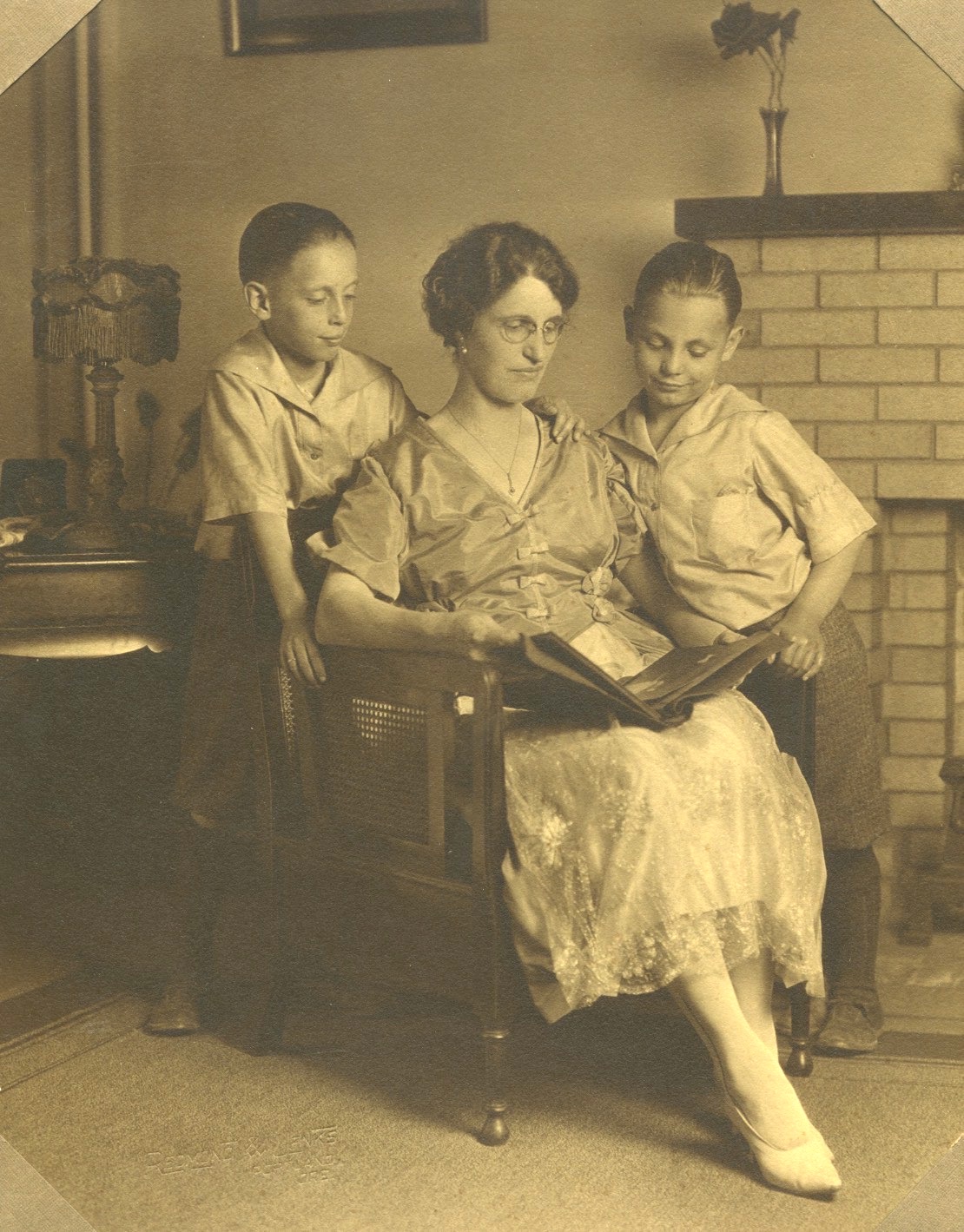
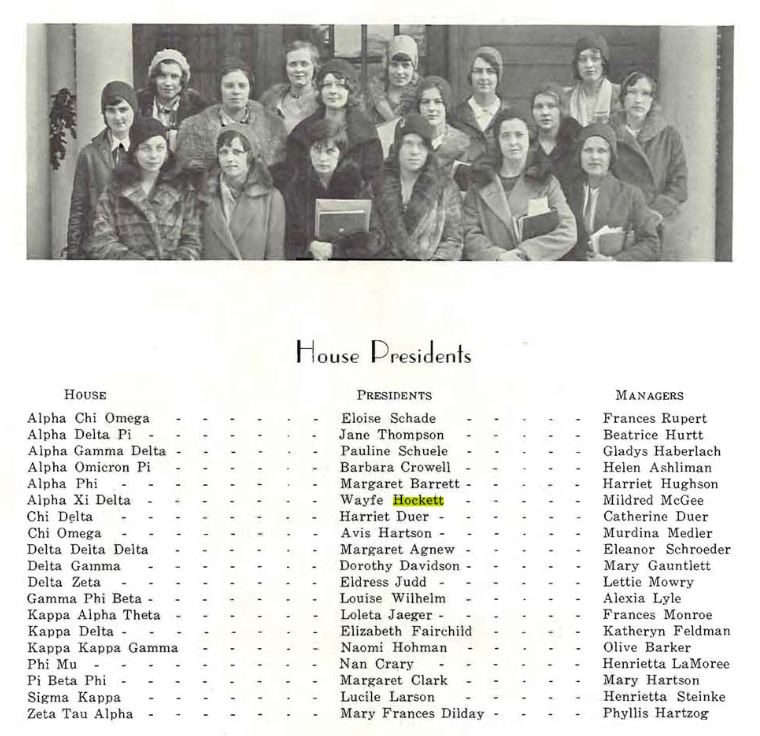 For Asahel see his narrative in the right menu bar…
For Asahel see his narrative in the right menu bar…
 Vernon during his college years ran into some problems with his eyes at the U of O in 1928.
Vernon during his college years ran into some problems with his eyes at the U of O in 1928.
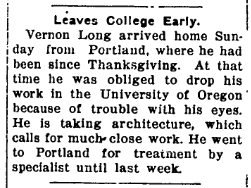

 In January of 1929 CT is a medical witness in a murder trial that absorbs much of the newspaper for several weeks. This is one of several public trials where CT will be a medical witness during his life. The West was a tough place to live in the early 20th Century.
In January of 1929 CT is a medical witness in a murder trial that absorbs much of the newspaper for several weeks. This is one of several public trials where CT will be a medical witness during his life. The West was a tough place to live in the early 20th Century.
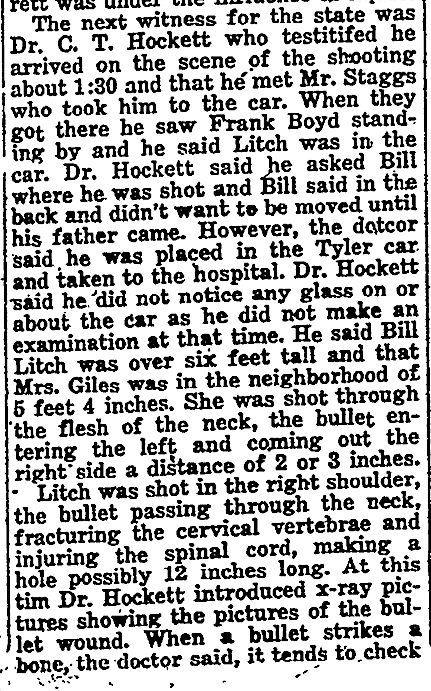 In February of 1929 Jesse Hockett, CT’s father passes on in Portland. This is the passing on of one of the well known pioneer figures in the Willamette Valley; there were prominent obits in the Portland papers. This was probably a sad blow to CT, requiring a train trip to Portland to attend the service.
In 1931 CT and son Ray are at a football banquet in Enterprise. Ray is about 17 years old. I have often suspected that if teenagers could see their parents photos in their teen years things would go easier between the generations.
In February of 1929 Jesse Hockett, CT’s father passes on in Portland. This is the passing on of one of the well known pioneer figures in the Willamette Valley; there were prominent obits in the Portland papers. This was probably a sad blow to CT, requiring a train trip to Portland to attend the service.
In 1931 CT and son Ray are at a football banquet in Enterprise. Ray is about 17 years old. I have often suspected that if teenagers could see their parents photos in their teen years things would go easier between the generations.
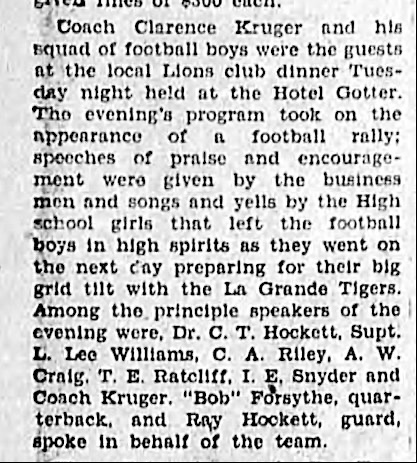
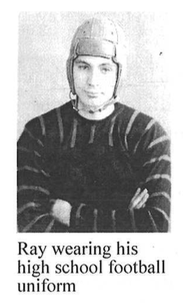 In 1933 CT buys back a service station he recently owned and puts Russell Wade, Louie’s brother, in charge. This is the same station that Jay and Ray will also help run. The service station will change hands again in 1934.
In 1933 CT buys back a service station he recently owned and puts Russell Wade, Louie’s brother, in charge. This is the same station that Jay and Ray will also help run. The service station will change hands again in 1934.
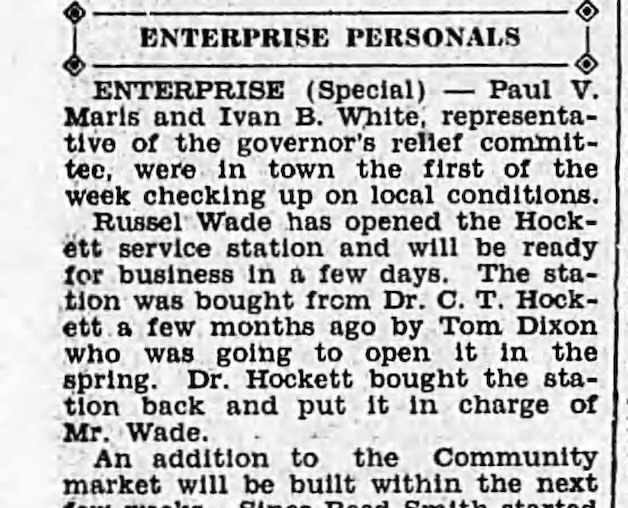 In Uncle Jay’s written history, The Hockett Family, he recounts the service station this way…
In Uncle Jay’s written history, The Hockett Family, he recounts the service station this way…
 Harold and Russell were Wade brothers, so it isn’t clear who CT put in charge of the station. The “Uncle Jay” above is Jay Bowerman. This is the Ford Runabout with the rumble seat with a couple of high school kids in 1932-33….
Harold and Russell were Wade brothers, so it isn’t clear who CT put in charge of the station. The “Uncle Jay” above is Jay Bowerman. This is the Ford Runabout with the rumble seat with a couple of high school kids in 1932-33….
 In 1932 CT, Louie, and Clifford Wade incorporate to form the Pine Creek Livestock Company out near the Zumwalt Buttes, north of Enterprise. Later articles will report the sale of cattle in that name. In 1930 CT purchased several hundred feeder lambs for the Joseph farm (which is a large purchase). In 1941 all of the Livestock Co. cattle were sold to a third party. 1941 is the same year CT is seriously injured when thrown from his horse. Perhaps CT is getting out of the cattle business out at the Buttes and intended to focus on the place on Prairie Creek and The Divide; probably spread too thin with a medical practice.
In 1932 CT, Louie, and Clifford Wade incorporate to form the Pine Creek Livestock Company out near the Zumwalt Buttes, north of Enterprise. Later articles will report the sale of cattle in that name. In 1930 CT purchased several hundred feeder lambs for the Joseph farm (which is a large purchase). In 1941 all of the Livestock Co. cattle were sold to a third party. 1941 is the same year CT is seriously injured when thrown from his horse. Perhaps CT is getting out of the cattle business out at the Buttes and intended to focus on the place on Prairie Creek and The Divide; probably spread too thin with a medical practice.

 In 1938 CT buys ten Karakul ewes, which are an ancient breed originating in central Asia around 1,400 B.C. This seems to be a time when CT is enjoying trying out various ideas on farming and ranching.
In 1938 CT buys ten Karakul ewes, which are an ancient breed originating in central Asia around 1,400 B.C. This seems to be a time when CT is enjoying trying out various ideas on farming and ranching.
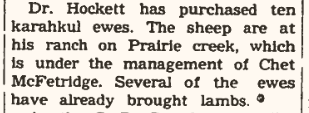
 During the 1930’s CT was also very busy every two years attending the Oregon State Legislature where he was elected in 1934. In 1937 he is appointed chairman of the Tax and Revenue Committee. Most of the important funding bills must pass through this committee to become law so this is a responsible position with lots of work involved. So many divergent activities; maybe CT is a bit bored with general medicine?
During the 1930’s CT was also very busy every two years attending the Oregon State Legislature where he was elected in 1934. In 1937 he is appointed chairman of the Tax and Revenue Committee. Most of the important funding bills must pass through this committee to become law so this is a responsible position with lots of work involved. So many divergent activities; maybe CT is a bit bored with general medicine?
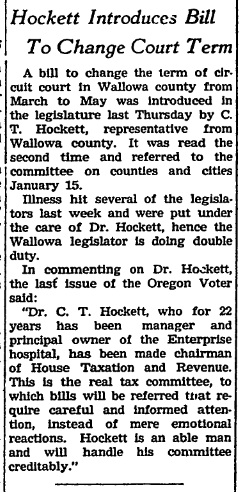 In January 1937 CT’s pioneer mother Sarah Booth Hockett passes away in Portland. Jesse died in 1929 so this is the end of the frontier relatives for CT. The 19th Century is being left behind. Probably a very poignant period of reflection for CT.
The other major event on December 20th, 1937 is that CT and Louie leave from La Grande on a long train trip across the country and do not return until a month later on January 19th.
In January 1937 CT’s pioneer mother Sarah Booth Hockett passes away in Portland. Jesse died in 1929 so this is the end of the frontier relatives for CT. The 19th Century is being left behind. Probably a very poignant period of reflection for CT.
The other major event on December 20th, 1937 is that CT and Louie leave from La Grande on a long train trip across the country and do not return until a month later on January 19th.
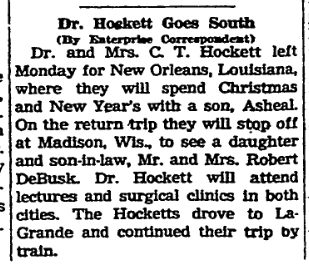 They go east through Wyoming, and then down through Kansas City, Memphis, and finally to New Orleans where Asahel, Lelah, and Sally are living and working. They arrive by December 24th and enjoy Christmas with them. They also visit Touro Infirmary one of the major hospitals in New Orleans where Asahel is director. CT and Asahel go fishing in the Bayou. From Louie’s diary:
They go east through Wyoming, and then down through Kansas City, Memphis, and finally to New Orleans where Asahel, Lelah, and Sally are living and working. They arrive by December 24th and enjoy Christmas with them. They also visit Touro Infirmary one of the major hospitals in New Orleans where Asahel is director. CT and Asahel go fishing in the Bayou. From Louie’s diary:

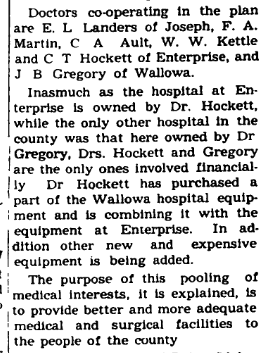


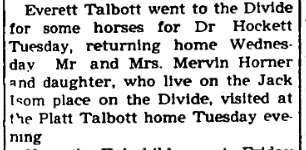 However, this period is also the start of serious medical issues and the decline in CT’s health. Remember that CT was seriously injured in 1925 in an auto accident. In 1941 he is thrown from his horse and again seriously laid up.
However, this period is also the start of serious medical issues and the decline in CT’s health. Remember that CT was seriously injured in 1925 in an auto accident. In 1941 he is thrown from his horse and again seriously laid up.
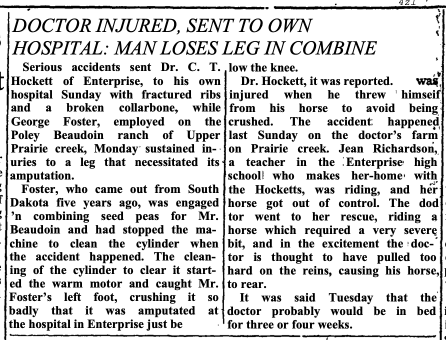
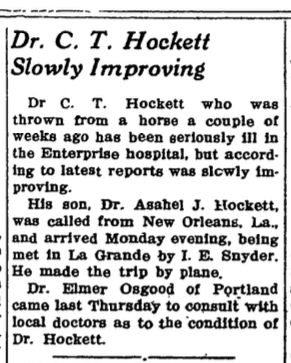
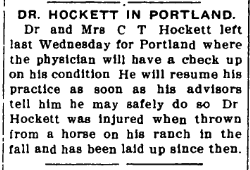
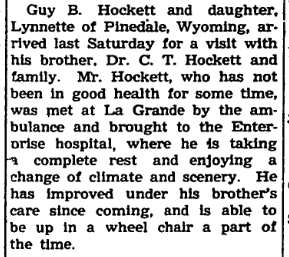
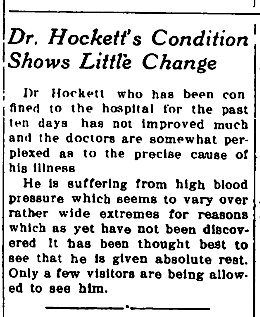
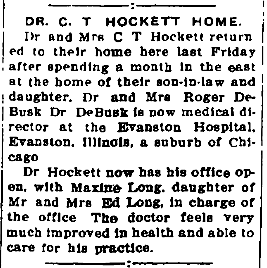 At the same time as all of this is going on in April of 1942, Louie has a humorous episode of getting locked in the attic of the Wade House by niece Judy Long, Vernon’s daughter.
At the same time as all of this is going on in April of 1942, Louie has a humorous episode of getting locked in the attic of the Wade House by niece Judy Long, Vernon’s daughter.
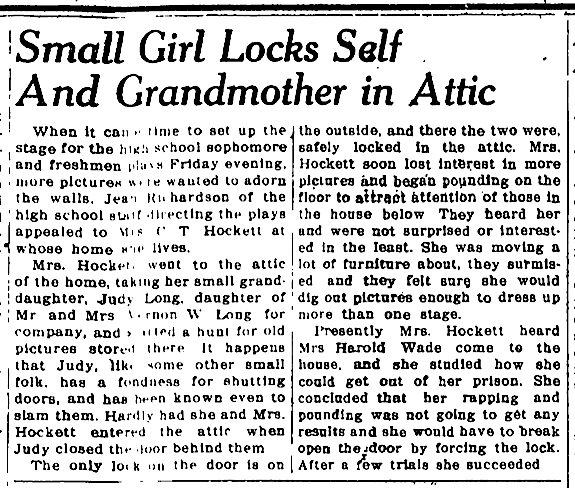 Now we are near the end of CT’s life and this is one of the last photos taken of him. He lives to be 65 years old, 1878 to 1943, so this photo is probably close to the end. CT is beginning to show the effects of injuries and health issues for a person of 64.
Now we are near the end of CT’s life and this is one of the last photos taken of him. He lives to be 65 years old, 1878 to 1943, so this photo is probably close to the end. CT is beginning to show the effects of injuries and health issues for a person of 64.
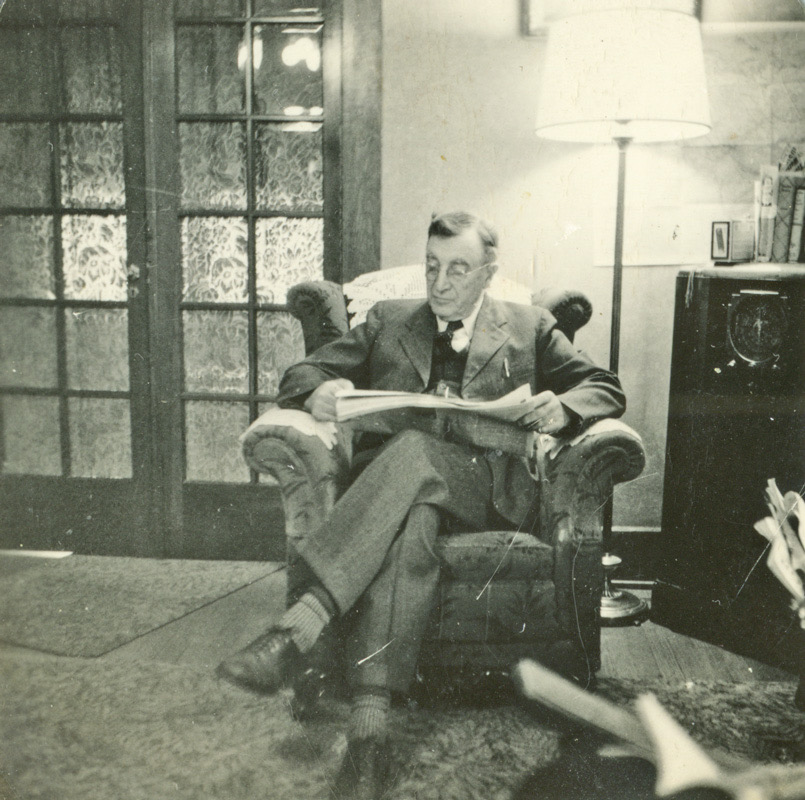 Wallowa County Chieftain news of CT’s death, 6-17-43 and accompanying Chieftain Essay On CT Hockett’s impact on the community…
Wallowa County Chieftain news of CT’s death, 6-17-43 and accompanying Chieftain Essay On CT Hockett’s impact on the community…

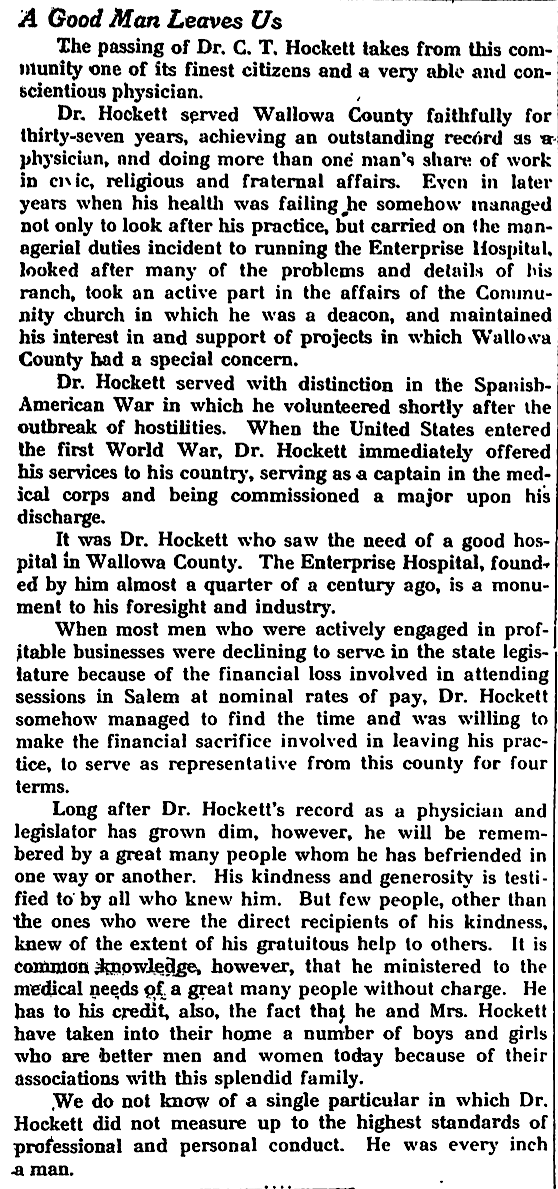 Grave site for CT and Louie at the Enterprise Cemetery. The grave was redone from the original which included a glass mirror orb on a pedestal. It was a very beautiful grave marker in that the glass reflected the country side very clearly. However, vandals kept breaking it so it was replaced with these stones.
Grave site for CT and Louie at the Enterprise Cemetery. The grave was redone from the original which included a glass mirror orb on a pedestal. It was a very beautiful grave marker in that the glass reflected the country side very clearly. However, vandals kept breaking it so it was replaced with these stones.
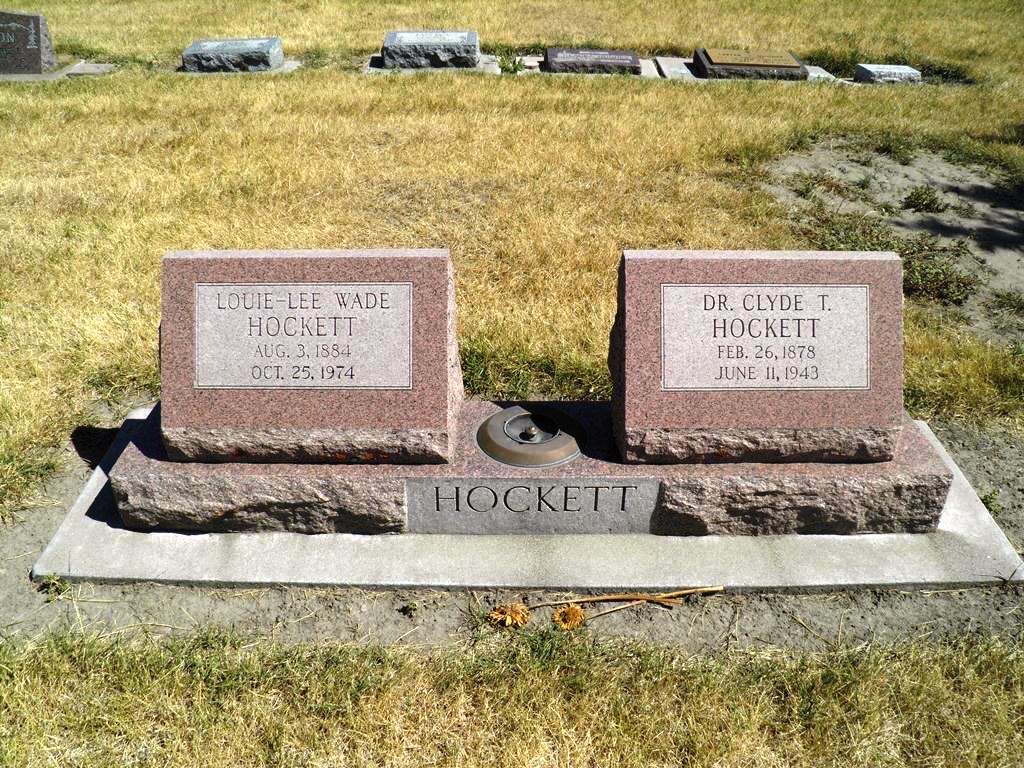
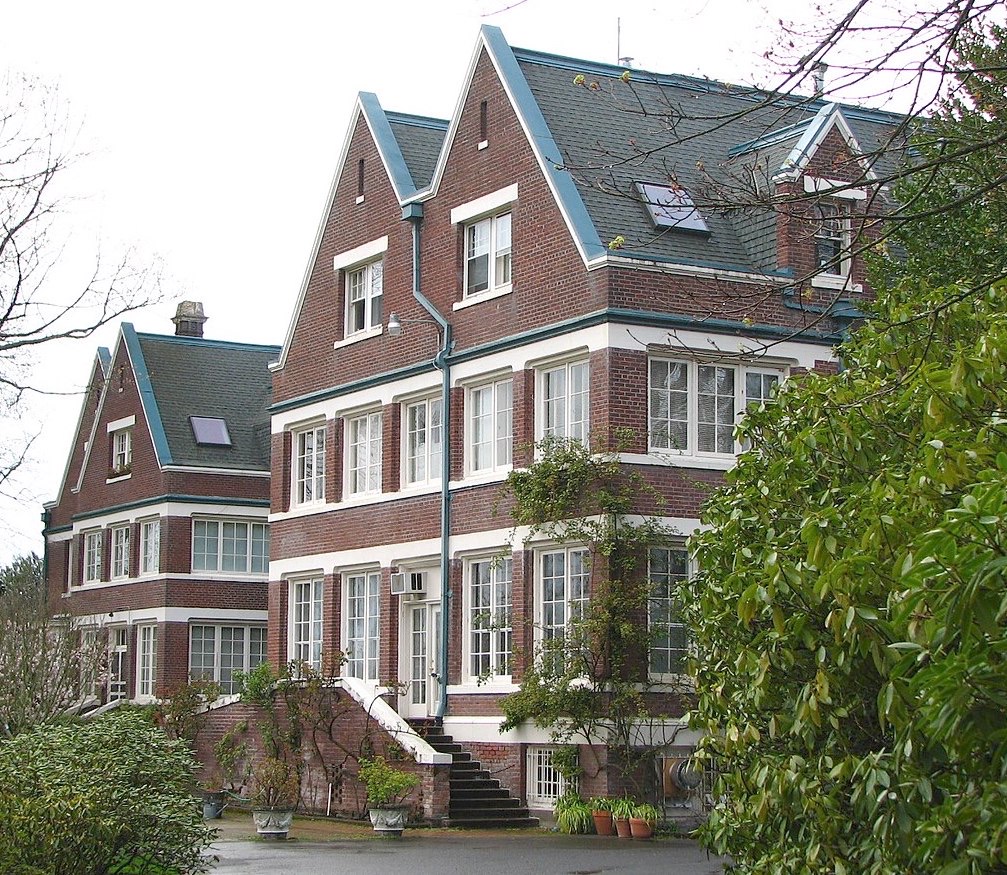

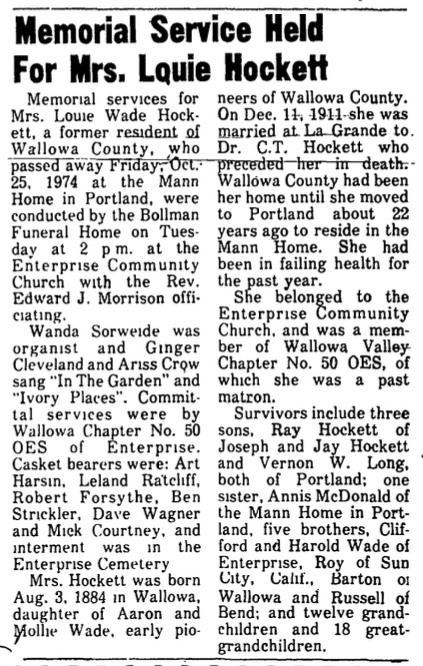
Narrative Archives
Major Hockett History Documents
Essays by Hockett Family Members